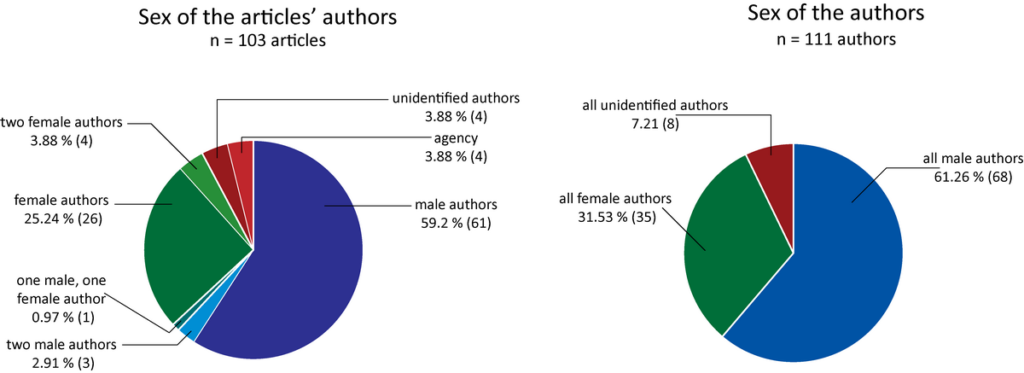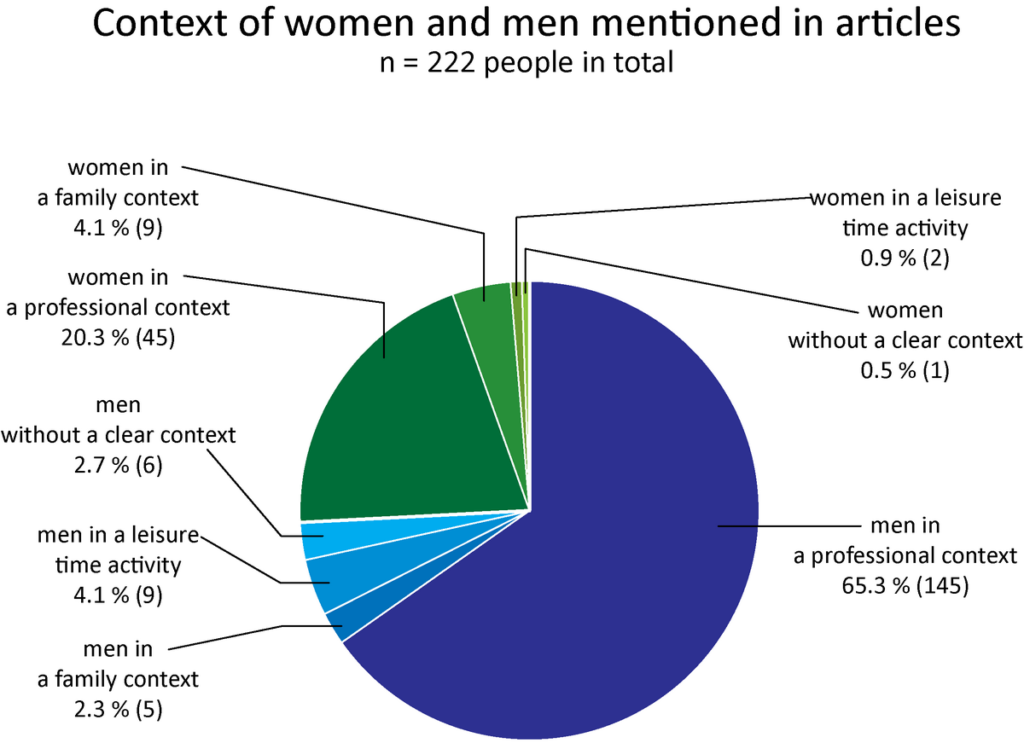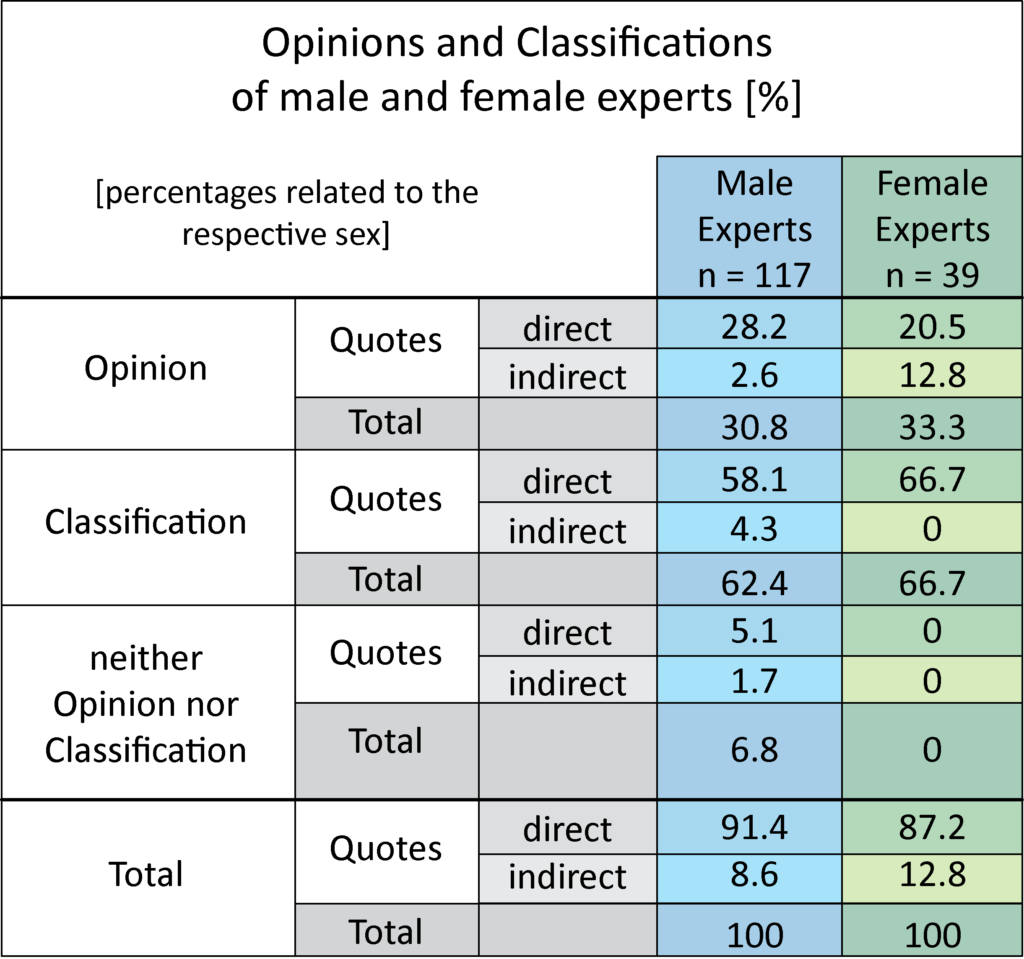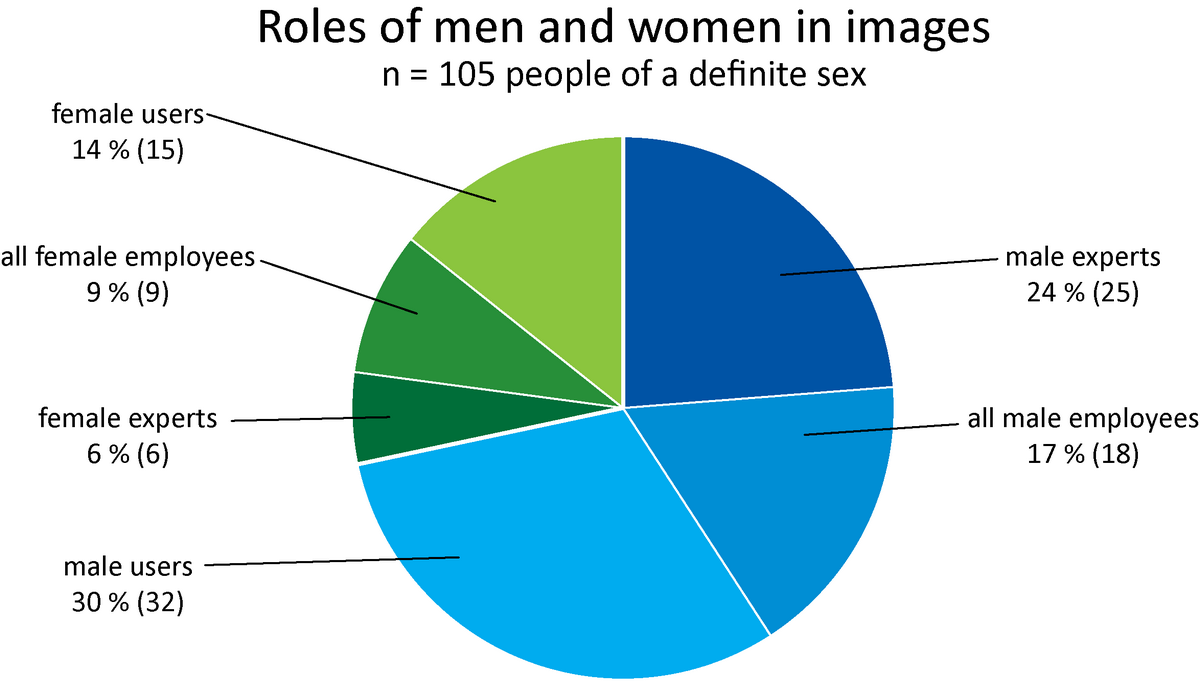Zuletzt aktualisiert am 15. Juli 2022
Wie werden Frauen und Männer in der Technikberichterstattung von The Guardian dargestellt? Dieser Frage sind Studierende des Masters Technik- und Innovationskommunikation in einem Lehrforschungsprojekt nachgegangen. Hier die Ergebnisse zum Thema Representation of Men and Women in Technology in the Online Magazine The Guardian
Zusammenfassung: Die allgemeine Konnotation von Technik mit Männlichkeit hat einen Einfluss auf die Berufswahl und das technische Verständnis junger Frauen. Durch eine bestimmte Darstellung von Männern und Frauen in den Medien wird diese Vergeschlechtlichung von Technik immer wieder hergestellt. Die vorliegende Studie des Technik-Ressort von The Guardian prüft, inwieweit auch in Großbritannien eine Konnotation von Technik mit Männlichkeiten überwiegt. Anhand einer quantitativen Inhaltsanalyse wurde untersucht, wie Männer und Frauen in dem britischen Online-Magazin in Bildern und im Text dargestellt werden. Zu diesem Zweck wurde zunächst untersucht, wie viele Journalistinnen und Journalisten in der Technikberichterstattung arbeiten und zu ihren verschiedenen Themen und Unterkategorien Beiträge verfassen. Zudem wurde analysiert, wie oft Männer und Frauen in den Artikeln erwähnt oder gezeigt werden. Hinzugezogen wurde auch der Kontext, in dem sie dargestellt werden, um Stereotype in der Berichterstattung des Technik-Ressorts zu identifizieren.
Abstract: Studies have shown that the general connotation of technology with masculinity has an impact on young women’s career choices and technical understanding. The troubling aspect is, as previous studies on German media have indicated, that media consolidate this problem by presenting men and women in a certain way. The present study investigates The Guardian’s technology section to see whether a connotation of technology and masculinity prevails in the United Kingdom, as well. With a quantitative investigation, we analyse how men and women in the technology section of the online magazine The Guardian are portrayed in images and texts. For this purpose, we first examine how female and male journalists are distributed in technology reporting and its various topics and sub-categories. Second, we analyse how often men and women are mentioned or shown. In addition, we also examine the context in which they are presented in order to identify stereotypes in the tech news coverage.
1. Introduction
The general connotation of technology and masculinity has a negative impact on the career choice and the technical understanding of young women. Only 22,8 % of all students in the engineering sciences in Germany in 2017 were female (cf. IT.NRW). However, programmes to introduce young girls and women to engineering have been initiated to counter these numbers. In addition, support programmes for employed female engineers were launched to prevent the drop-out of highly qualified women climbing the career ladder. Despite these efforts, the percentage values of women in engineering sciences and engineering jobs are not rising significantly. Current studies prove that cultural expectations and attitudes are responsible (cf. Paulitz 2012).
How is it that only 15 % of German parents can imagine an engineering career for their daughter, whereas 40 % can imagine the same for their son? (cf. OECD 2015: 140) From the viewpoint of culture and communication sciences, media play a major – perhaps even the central – role here. “Whatever we know about our society, or indeed about the world in which we live, we know through the mass media”, said the sociologist Niklas Luhmann (2000: 1). The media mediate between science, economy, politics and society. The images and metaphors on the internet, in newspapers, on the radio and television influence the perception of technology and male/female engineers.
The importance of media for women’s interest in technology
The correlation between gender and technology-related news coverage is sparely researched. Heilemann, Hackl, Neubauer and Stöger provided a research overview in 2012 in their anthology “Mädchen und Frauen in MINT” (“Girls and women in STEM”). According to the anthology, media influence different aspects: for example, the interest in STEM, the confidence in one’s STEM skills, the assessment of one’s ability to perform in a STEM-related career or the intention to choose one. Notably, the representation of women in technology-related careers plays an important role (cf. Heilemann, Hackl, Neubauer, Stöger 2012: 79). For instance, they showed that role models in newspaper articles can contribute to breaking away from gender stereotypes (cf. Heilemann, Hackl, Neubauer, Stöger 2012: 80). The Geena Davis Institute published several papers confirming the “Scully Effect”: female role models in films and TV shows influence many girls and women in the United States toward more positive beliefs about STEM and encourage them to consider STEM as a career field (cf. 21st Century Fox, The Geena Davis Institute on Gender in Media, J. Walter Thompson Intelligence 2018: 6).
Representation of women in the media
Studies of the presentation of women in the media have a long tradition. Research shows that traditional media (TV, radio and print) perpetuate and consolidate traditional female roles (cf. Lüneborg, Maier 2013: 98 et seqq.). The Global Media Monitoring, conducted every five years since 1995, shows that the percentage of women featured by the traditional media is gradually growing. However, they still distort the sex ratio to the disadvantage of women. The 2010 National Report of the United Kingdom and Northern Ireland from the Global Media Monitoring Project discovered that men are generally more than twice as likely to appear in news. Most women (43 %) appear in the social and legal category – usually as victims of crime and discrimination (cf. Global Media Monitoring Project 2010: 8). Moreover, the analysis showed that women in the print media mainly appear as eyewitnesses, contribute personal experiences or talk about the public opinion. Men, on the other hand, are more likely to take on the role of experts, protagonists or speakers for an organization or group (cf. Global Media Monitoring Project 2010: 10).
A large-scale analysis of high-quality media by Jutta Röser and Kathrin Friederike Müller about the representation of female and male managers in politics, economics and science confirms: with the exception of the German federal chancellor Angela Merkel, fewer women were shown in all these fields than exist in reality. In economics, 17 % female and 83 % male managers were mentioned. In politics, the percentage values were similar, with 20 % female and 80 % males mentioned on the news. However, in reality the percentage of female top-ranking politicians was considerably higher in the period of examination, namely 30%, proving a sex-specific selection to the disadvantage of women in the media (cf. Röser, Müller 2012: 45 et seqq.).
More specialized magazines, especially upper-class women’s venues, paint a different picture: women are shown as career-oriented, confident and independent. Heilemann, Hackl, Neubauer and Stöger (2012: 81 et seqq.) state that the percentage of women in technology in women’s magazines is rising continually; however, this does not correlate with the percentage of women actually working in STEM-related fields. Ziesmann and Denz are currently examining the image of women in STEM fields in the online magazines of well-known daily and weekly German newspapers using content analysis methods. Their first insights show that women in STEM often appear as role models in reporting, being either thematised or chosen as professional interview partners. Gender-appropriate language, however, is still far from ubiquitous; the generic masculine is often used. Measures to promote women and women’s initiatives are often discussed without being evaluated. The reporting differs between formats: for instance, Bild, a German tabloid, reports on STEM topics less frequently. All in all, Ziesmann and Denz come to the preliminary conclusion that the reporting of women in the STEM area is heterogeneous but frequently suffers from stereotypes and clichés (cf. Ziesmann, Denz 2018: 49 et seq.).
But how is technology communicated: is a connotation of technology and masculinity noticeable? This question has not been studied so far. For the news coverage of technology topics, we still need to ask: first, is there is a discrepancy between the depiction of women in technology and the reality? Second, if yes, how can this discrepancy can be corrected?
The research project “Technik – Gender – Journalismus” (Technology – Gender – Journalism) of the Electrical Engineering, Mechanical Engineering and Technical Journalism faculty at the Bonn-Rhein-Sieg University of Applied Sciences considers journalism and its production to examine how the media can liberate technology from gendered connotations.
The project aims to investigate how women and men in technology are represented in journalism. In addition, it aims to produce a guideline to help journalists enhance their writing and avoid stereotypes. You may ask: how can journalism contribute to solving the problem while preserving an impartial point of view? After all, independent journalism is not supposed to take a side, for instance, by promoting female engineers for the sake of social interests. However, it can take the topic of women and technology into the agenda. It can also avoid strengthening the culturally developed connotation of technology and masculinity by the frequency and the modality of genders being mentioned or by the way technology is depicted and imparted.
Representation of women in technology news reporting
The project started its research with a study of two well-known local newspapers, the General-Anzeiger Bonn and the Kölner Stadt-Anzeiger (Cologne). The results: only 19 % of technology-related articles were written by women. Moreover, only 17.6 % of the articles mention women as experts. The images also show men significantly more, with 81.3 % men and only 18.7 % women. It is to be noted, though, that these percentages roughly correspond with the low percentage of women in technology fields. Men were also shown in a stereotypical way, dealing with heavy machines – but women, in contrast to our apprehensions, were not shown with stereotypical items such as household appliances (cf. Keil, Leonhardt 2017).
A second non-published study aimed to analyse the quality of the schooling platform “technikjournal” for the course of studies Technikjournalismus/PR (Technical Journalism and PR) of the Bonn-Rhein-Sieg University of Applied Sciences. The analysis showed that 42 % of technology-related articles were written by women. Hence, roughly two times more women write in the “technikjournal” than in the analysed well-known newspapers. Similar to the local newspapers, the majority of experts were men. Still, female experts appeared more often than in the local newspapers. The investigation of images and videos showed: 28 % showed men with technology, 7% showed both men and women, and only 6 % showed women. 46 % of technology was shown without people. This research indicates that women in technology fields are less visible in the investigated media in Germany, though more research is needed to come to a conclusion for all German media (cf. Sommershof, Tittko 2017, Kirschner, Keil, Seuser, Siefer 2020: 4).
The underrepresentation of women in reporting on all topics seems to be a widespread problem – as it is also in the United Kingdom (cf. Global Media Monitoring Projekt UK and the Republic of Ireland 2015: 7 et seqq.). Therefore, the research project aims to broaden its perspective through investigating media in other countries, in a first step in Europe, such as the United Kingdom, with a special focus on technology. The present study concentrates its analysis on the technology department of The Guardian’s online magazine and its representation of men and women in technology-related fields. The Guardian was chosen because English newsreporting can reach a large readership, it is known as a very innovative newspaper in terms of digital journalism, and it is the only one in the United Kingdom with a tech department. In addition, it is a very liberal newspaper, where we expected different results from the local German newspapers.
2. Materials and Methods
To answer our research questions, we used a quantitative investigation of 103 articles dating from November 15th to November 26th, 2017. We only included articles of The Guardian’s technology department to analyse how women and men are pictured in technology-related articles. Due to the increasing importance of digital journalism and the ease of accessibility, we used online articles.
With a test run of our coding, we optimised our codebook for the chosen articles. In addition, we used the inter-rater reliability to ensure that our coders were as objective as possible and that our scales were appropriate for measuring gender aspects as required by our study. The test run of our coding helped to familiarise the coders with categories and classifications, thus eliminating errors. It was a challenge to arrange the data in a way that would enable us to compare different variables with each other. Here, the statistic software SPSS was used to organise all variables. In addition, we used two different codebooks, one for text content and one for image content.
Another challenge was the coding of images with the variable “dominance”, as some images were difficult to clearly categorise. We chose to use several different categories that were relevant for this study, for example, “male protagonist”, “female protagonist”, “technology”, “men and technology”, “women and technology”, as well as “men and women”. Additionally, we included categories for non-gendered robots. The additional category “undiscernible/irrelevant” included the dominance of images that were not relevant for this study. Furthermore, we also coded the total number of male and female figures in images – including gendered robots, animals and figurines. Other variables coded the roles of the first three people visible in images, as well as gender stereotypes.
We also arranged the articles into categories according to the sorting system of The Guardian. This presented us with a challenge, as The Guardian publishes articles on a great variety of topics in the technology department. We agreed to use the Uniform Resource Locator (URL) to arrange the articles into distinct categories and sub-categories. To ensure that these categories are distinct enough, we also added a variable for the topic and the keyword chosen by The Guardian to cross-examine our results. For the texts, we also included variables to account for the total number of male and female persons as well as the roles of the first three people mentioned. Moreover, we considered the number of quotes and if the protagonists were quoted directly or indirectly. When both types of quoting were present, we prioritized direct quotations, considering them to be more meaningful and weightier.
3. Results
Authors and photographers tend to be male
The authors of the 103 analysed articles in The Guardian’s technology news were mostly male. Our data showed that female journalists were clearly underrepresented, with only 31.5 % (compared to 45 % female journalists in the United Kingdom overall, according to The Worlds of Journalism Study; cf. Thurman, Cornia, Kunert 2016: 8). Still, female journalists are significantly more present in The Guardian’s technology department than in German local newspapers General-Anzeiger Bonn and Kölner Stadt-Anzeiger, with only 19 % of technology articles written by women (cf. Keil, Leonhardt 2017: 27-34). The data could indicate that the United Kingdom is somewhat further ahead than Germany in the gender equality of journalists. On the other hand, it could also point to a significant imbalance in the representation of female journalists between local and national newspapers. Some studies have compared the proportions of women in the top echelons of German local and national newspapers (cf. Pro Quote 2013), but so far, there has been no comparison of the proportion of women on their entire editorial staff. Moreover, The Guardian is a liberal publication that takes care not to alienate feminist readers. Studies of the representation of women in the UK media are sparse (cf. Matias, Cherny 2012) and they rarely compare local and national newspapers.

Articles in The Guardian’s technology department are organised into several topics, such as “technology”, “business and money” and several others. We found that articles written by male journalists are more likely to belong into the “technology proper” section with 71.7 % (33 of 46 articles). Feminist communication studies assume that the former gender-specific division of responsibilities, according to which men report more on politics, economics and sport, while women write predominantly about culture and local affairs, is now outdated (cf. Lünenborg, Maier 2013: 81 et seqq.). However, this does not yet appear to be the case for technology coverage. Moreover, female photographers are almost invisible, with only 6 % compared to 37 % male photographers; for more than half of the images, 57 % of 284 photos, the photographer’s gender could not be identified as no information was provided, or the photograph originated from data bases, an agency or public relations; this lack might be distorting the analysis.
More men than women are present in technology articles
Our hypothesis that more men than women are present in technology articles of The Guardian is validated for this sample. In articles’ texts, women are underrepresented with 26 % (102 of 394 people in total) compared to 64 % men. The calculation of the mean value also supports this result: on average, 2.46 men and 0.99 women appear per article.
The underrepresentation of women continues in the 284 images: 63 % of the images show men (112 of 178 people), and only 37 % (66 of 178 people) show women. Interestingly, women are more likely to be shown in images (37%) than appear in the text (26 %). Studies have indicated that images have a higher impact on the subconscious and the personal opinion of the readers (cf. Schmidt, Schneider 2018: 118-120). In addition, the way women are shown is of great importance. Considering that we could hardly find any stereotypes in images, the higher visual representation of women is a positive development that should be further encouraged and extended.
Compared to German local newspapers, where women appeared only in 18.7 % of the images and 17.6 % of the texts (cf. Keil, Leonhardt 2017: 29-30), The Guardian represents women significantly more frequently.
Stereotypical depictions of men and women
Stereotypes in the written part
All in all, the amount of stereotyping in the texts is quite low. We analysed the genders and functions of the first three people in the articles as well as the contexts in which they were mentioned. We categorised the protagonists as follows: 1) experts who classify and evaluate technology, 2) founders who do not make any classifications or statements, and 3) users who only use technology and do not classify it.
From 222 people, women functioned as experts in 15.8 % of the cases, in contrast to 41.9 % male experts. Furthermore, the founders, developers and managers mentioned also tended to be male, with 24 men as opposed to 4 women mentioned in this category (10.8 % male and 1.8 % female). The distribution of users was balanced, and the overall numbers low, with 7 men and 7 women.
Even though women were mentioned in a job-related context only in 20.3 %, while men were mentioned over three times more (65.3 %), within each gender category, the distribution is similar: 78.9 % of women and 87.9 % of men who are mentioned appear in a job-related context. Both men and women were rarely mentioned in leisure contexts with 5.5 % men and 3.5 % women. However, women were much more likely to be mentioned in a family-related context, with 15.7 % in contrast to only 3 % of the men.


The percentages correlate with real-life statistics: 20.3 % of the women in the technology department of The Guardian are mentioned in a professional context, while the statistics for the UK estimate that women make up 20.3 % to 21.62 % of the workforce in STEM-related jobs and industries. The percentage of female experts mentioned is only 15.8, which is still somewhat higher than the percentage of women in SET occupations in the UK (12.3). To conclude, in this case female experts are not underrepresented by journalists; rather, the articles mirror the low number of women working in SET occupations.
This impression is reinforced by the fact that 61 % of the women mentioned appear as experts (compared to 56 % of the men). This result stands in contrast to studies that show how media can provide a filter that intensifies unequal gender relations present in reality (cf. Lünenborg, Röser 2012, Lünenborg/Maier 2013: 98 et seqq.).
We expected to see a significant difference in the way men and women are mentioned. However, the data only indicates a tendency to portray men almost exclusively in a job-related context.
In comparison: 15.2 % of women in Germany work in mathematics, computer science, natural sciences and technology (cf. Bundesagentur für Arbeit, Statistik/Arbeitsmarktberichterstattung 2018: 8), which correlates with the low percentage of female protagonists found in technology-related articles of German local newspapers, 17.6 % (cf. Keil, Leonhardt 2017: 29). However, this percentage includes women identified as interview partners, users and experts. Therefore, a direct comparison with the numbers we gleaned from The Guardian’s technology section is difficult.
Stereotypes in images
Overall, visual gender stereotyping is very low with only 2.8 % (8 out of 284 images). Analysing the roles of the 105 men and women depicted, we could identify some gender-specific roles, for example, women as users rather than developers of technology. Additionally, we used a variable to identify if men or women were shown in a stereotypical way, for example, men with heavy machines or women in the household.


We found that 50 % of the women were pictured as users, 30 % shown as employees, and only 20 % as technology experts. Men, on the other hand, are shown as users in 42.6 % of the cases, as employees in 24 % and as experts in 33.3 %. We expected men to be more frequently represented in a stereotypical way, as a study of local German newspapers uncovered 22.1 % stereotypes in images (44 in total; cf. Keil, Leonhardt 2017: 30) – but we could not validate this hypothesis. Besides, stereotypes in images are so rare (with only 8 images in total) that the numbers are negligible.
Comparison text/images
In The Guardian’s technology section, stereotyping was overall gratifyingly low in both texts and images. However, a small difference can be seen: women in the texts are often mentioned in job-related context (78.9 %), while in images, only half of the women are shown as employees or experts. It is to be noted, though, that men in images were also less often shown as employees or experts (57.3 %, compared to 87.9 % textual mentions in job-related contexts).
Along with a more equal gender distribution among technology journalists, the data of The Guardian shows that this news magazine features fewer stereotypes in images and texts compared to local German newspapers. However, it indicates no imbalance in the way men and women are portrayed in local and national newspapers across borders. Furthermore, the political orientation of a newspaper and its corporate culture must certainly have an impact on the stereotypes in images and text. Additional research is needed to validate or falsify these theories.
Men explaining technology
From a total of 164 citations, 71.3 % belonged to male experts and only 23.8 % to female ones. However, if we relate the percentages to the number of quotations of the respective gender, women are somewhat more likely to provide a classification (66.7 % compared to men with 62.4%) or an opinion (33.3 % compared to men with 30.8%). However, if we delve deeper into the figures, other differences become obvious: male experts are less likely to be quoted indirectly (only 8.6 %), whereas female experts are quoted indirectly in 12.8 % of the cases.


The data shows a clear imbalance to the disadvantage of female experts (only 23.8 % of all citations) – which, however, corresponds with the low percentage of women working in STEM industries in the UK (20.3 % to 21.65 %; cf. Kirkup, Zalevski, Maruyama, Batool 2010: 74-75, and WISE 2015: 18-20). Therefore, one cannot assume that journalists were excluding female experts in the technology field from their reporting. Rather, the imbalance results from the low proportion of women in STEM-related jobs.
In comparison with local German newspapers, The Guardian gives female experts more room for quotes (23.8 % compared to only 17.6 %). Nevertheless, these percentage values for German newspapers also correspond with the number of women in STEM-related jobs is Germany (15.2 % in mathematics, computer science, natural sciences and technology; cf. Bundesagentur für Arbeit, Statistik/Arbeitsmarktberichterstattung 2018: 8).
Male experts also predominate at the schooling platform “technikjournal”, commenting about twice as often on technical developments as women: in 59.5 % cases, only male experts are cited, compared to 25.9 % with only female experts of a total of 116 experts. In 14.7 % of the cases, both male and female experts are consulted. The number of female experts at the platform is thus somewhat higher than at The Guardian. However, even on a schooling platform, where the gender representation can be influenced, the numbers are still quite low. (cf. Technikjournal im Gender-Check)
Limitations of the study
Our analysis of 103 articles published by The Guardian is not adequate to represent all articles in the technology department. However, it can show tendencies, which should then be analysed on a broader scale. Comparisons with previous research on local German newspapers are difficult as too many variables were different and studies were analysing different newspaper types: local vs. national, German vs. English, with different journalistic practices, political orientations and corporate cultures. Still, the study of local German newspapers can be seen as a first attempt to analyse gender differences in articles about technology, which we followed up in this study of The Guardian. Additional improvements will be made by further investigations. Furthermore, it should be interesting to compare older articles with newer ones to see if the representation of women in technology coverage is improving and if more work on gender equality is necessary. Moreover, several newspapers should be analysed to see if the United Kingdom in general is on a good way to gender equality in technology reporting.
4. Conclusion
Our study shows partial gender equality in reporting on technology issues in The Guardian. Our quantitative investigation of 103 articles found a connotation of technology with masculinity, for example, in the number of male journalists (nearly 60 %) as well as male protagonists (64 %) in the articles, compared to only 26 % women protagonists. Furthermore, the number of male experts (almost 42 %, compared to 16 % female experts) underlines the male dominance in technology. Experts have a crucial role in technical journalism since they give an opinion about a product or a technological development and rank its importance for the readers.
We found male dominance not only in the written part but also in the photos (with 63 % men out of 178 people in total). This supports our main hypothesis that men and women in the technology section of The Guardian are not represented equally, and that a connotation of technology with masculinity is present. However, the number of female protagonists (26 %) actually slightly exceeds the number of women working in STEM-related jobs in the UK (21.62 %, cf. WISE 2015: 18-20). The percentage of female experts such as engineers in the articles also slightly exceeds the percentage of women working in SET occupations in the UK, which is currently 12.3 % (cf. Kirkup, Zalevski, Maruyama, Bartool 2010: 74-75). Thus, the underrepresentation of women in technology-related articles is rooted not in journalistic practices but in the real-life underrepresentation of women in STEM- and SET-related jobs and occupations.
Compared to previous research of German local newspapers, the technology coverage of The Guardian is on the right way to gender equality. The Guardian publishes more technology-related articles by women than German local newspapers (31.5 % versus 19 %). Moreover, women are more present in images in The Guardian (37 %, compared to only 18.7 in the German newspapers analysed). The Guardian also gives female experts more room for quotes: 23.8 %, compared to only 17.6 % in local German newspapers. Differences also occurred in stereotypes: while both studies have shown a low percentage of stereotyping, the German local newspapers more often showed men in a stereotypical way. In The Guardian, stereotypes in images were extremely rare (only 2.8 %), and if they occurred, the portrayal of both men and women equally suffered from clichés.
5. Acknowledgments
We would like to thank Dr. Christine Buchholz for her expert advice and support in the statistics as well as Dr. Nina Leonhardt for her indispensable contribution to the conception of the research project. Additionally, we thank the participating students from the master’s course Technik- und Innovationskommunikation (Communication of Technology and Innovation) who were instrumental in developing and coding this study: Anna Tipping, Freya Wolff, Nadja Krenzien, Aaron Skiba and Pascal Breuer.
Autors: Susanne Keil & Deliah Michely
6. Literature
Bundesagentur für Arbeit, Statistik/Arbeitsmarktberichterstattung (September 2018): Berichte: Blickpunkt Arbeitsmarkt – MINT – Berufe, Nürnberg. Online: https://statistik.arbeitsagentur.de/Statischer-Content/Arbeitsmarktberichte/Berufe/generische-Publikationen/Broschuere-MINT.pdf [accessed 10.01.2019]
21st Century Fox, The Geena Davis Institute on Gender in Media, J. Walter Thompson Intelligence (2018): The “Scully Effect”: I want to believe in STEM. Online: https://seejane.org/wp-content/uploads/x-files-scully-effect-report-geena-davis-institute.pdf [accessed 29.08.2018]
Global Media Monitoring Project (2015): Who makes the news? Four Nation Report: England, Scotland, Wales and the Republic of Ireland. Online: http://cdn.agilitycms.com/who-makes-the-news/Imported/reports_2015/national/UK.pdf [accessed 13.07.2018]
Global Media Monitoring Project (2010): National Report United Kingdom & Northern Ireland. Online: http://cdn.agilitycms.com/who-makes-the-news/Imported/reports_2010/national/UK.pdf [accessed 13.07.2018]
Hanitzsch, Thomas/Steindl, Nina/Lauerer, Corinna (2016): Country Report: Journalists in Germany. Worlds of Journalism Study. Online: https://epub.ub.uni-muenchen.de/28095/1/Country%20report%20Germany.pdf [accessed 14.08.2018]
Heilemann, Michael/Hackl, Julia/Neubauer, Tanja/Stöger, Heidrun (2012): “Die Darstellung von Mädchen und Frauen in den Medien.” In Stöger, Heidrun/Ziegler, Albert/Heilemann, Michael (ed.) (2012): Mädchen und Frauen in MINT – Bedingungen von Geschlechterunterschieden und Interventionsmöglichkeiten, Lehr-Lern-Forschung vol. 1. Berlin: LIT.012, p. 77-102.
IT.NRW (2017): Studierende in den Ingenieurwissenschaften im Jahr 2017. IT.NRW, Düsseldorf, amtliche Hochschulstatistik/Studierendenstatistik, Sonderauswertung, Bearbeitung: KoFo Netzwerk Frauen- und Geschlechterforschung NRW. Online: https://www.gender-statistikportal-hochschulen.nrw.de. [accessed 15.02.2022]
Journalistinnenbund e.V. (2015): GMMP 2015: Ergebnisse. Online: https://www.journalistinnen.de/projekte/gmmp/weltweite-medienbeobachtung-gmmp-2015-ergebnisse/
Keil, Susanne/Leonhardt, Nina (2017): Technikjournalismus im Gender-Check. In: Journal Netzwerk Frauen- und Geschlechterforschung NRW Nr. 39/2017, p. 27-34. Online: https://www.netzwerk-fgf.nrw.de/fileadmin/media/media-fgf/download/publikationen/Journal-39_Netzwerk-FGF.pdf [accessed 13.08.2018]
Kirkup, G., Zalevski, A., Maruyama, T. and Batool, I. (2010). Women and men in science, engineering and technology: the UK statistics guide 2010. Bradford: the UKRC. Online: https://wise.statementcms.com/uploads/wise/files/archive/final_sept_15th_15.42_ukrc_statistics_guide_2010.pdf [accessed 08.08.2018]
Luhmann, Niklas (2000): The Reality of the Mass Media. Oxford: Polity Press.
Lünenborg, Margret/Röser, Jutta (2012): Ungleich mächtig – Das Gendering von Führugnspersonen aus Politik, Wirtschaft und Wissenschaft in der Medienkommunikation. Bielefeld: transcript.
Lünenborg, Margret/Maier, Tanja (2013): Gender Media Studies. Eine Einführung. Konstanz: UVK Verlagsgesellschaft, esp. p. 26-31 and 97-107.
Matias, J. Nathan/ Cherny, Lynn (2012): Women’s representation in media: the best data on the subject to date. Online: https://www.theguardian.com/news/datablog/2012/sep/07/gender-media-best-data-available [accessed 10.10.2018]
MonitorING database of the VDI. Online: www.vdi.de/wirtschaft-politik/arbeitsmarkt/monitoring-datenbank/#hochschule [accessed 17.08.2018]
OECD (2015) (ed.): The ABC of Gender Equality in Education: Aptitude, Behaviour, Confidence. Online: https://www.oecd.org/pisa/keyfindings/pisa-2012-results-gender-eng.pdf [accessed 04.10.2016].
Paulitz, Tanja (2012): Mann und Maschine. Eine genealogische Wissenssoziologie des Ingenieurs und der modernen Technikwissenschaften, 1850-1930. Bielefeld: transcript Verlag.
Prommer, Elizabeth / Linke, Christine / Stüwe, Julia (2017): “Is the future equal? Geschlechterrepräsentationen im Kinderfernsehen.” In: TELEVIZION 30/2017/2, p. 4-10, Online: http://www.br-online.de/jugend/izi/deutsch/publikation/televizion/30_2017_2.htm [accessed 30.07.2018]
Pro Quote (2013): Frauenanteil in Führungspositionen deutscher Redaktionen – erste Datenerhebung 2013. Online: www.pro-quote.de/statistiken [accessed 19.09.2018]
Röser, Jutta/Müller, Kathrin Friederike: “Merkel als ‚einsame Spitze‘. Eine quantitative Inhaltsanalyse zum Geschlechterverhältnis von Spitzenfrauen in den Medien.” In: Lünenborg, Magareth/Röser, Jutta (Hg.) (2012): Ungleich mächtig. Das Gendering von Führungspersonen aus Politik, Wirtschaft und Wissenschaft in der Medienkommunikation. Bielefeld: transcript, 37-63.
Lünenborg, Magareth/Röser, Jutta (Hg.) (2012): Ungleich mächtig. Das Gendering von Führungspersonen aus Politik, Wirtschaft und Wissenschaft in der Medienkommunikation. Bielefeld: transcript.
Scheer, Uta (2002): “’Geschlechtsreproduktionen’ in populären Fernsehtexten. Oder: Was kann ein weiblicher Captain?” In: Klaus, Elisabeth/Röser, Jutta/Wischermann, Ulla (ed.) (2002): Kommunikationswissenschaft und Gender Studies. Opladen: Westdeutscher Verlag, 103-123.
Schmidt, Sabine/Schneider, Juliane (2018): Die Bedeutung des genderspezifischen Technikzugangs für die Konzeption einer Technikzeitschrift – Eine Untersuchung auf Basis computergestützter Messverfahren der Sozialpsychologie zur Erhebung der impliziten und expliziten Einstellungen zum Thema Technik und der Aufbereitung von technischen Inhalten. Unpublished master thesis, Bonn-Rhein-Sieg University of Applied Sciences.
Stöger, Heidrun/Ziegler, Albert/Heilemann, Michael (ed.) (2012): “Mädchen und Frauen in MINT – Bedingungen von Geschlechterunterschieden und Interventionsmöglichkeiten”, Lehr-Lern-Forschung vol. 1. Berlin: LIT.012
Thurman, Neil/Cornia, Alessio/Kunert, Jessica (2016): Journalists in the UK. Oxford: Reuters Institute for the Study of Journalism. Online: http://reutersinstitute.politics.ox.ac.uk/publication/journalists-uk [accessed 14.08.2018]
Uhlemann, Ingrid Andrea (2015): Einführung in die Statistik für Kommunikationswissenschaftler: Deskriptive und induktive Verfahren für das Bachelorstudium. Wiesbaden: Springer Fachmedien. WISE (2015): Women in Science, Technology, Engineering and Mathematics: The Talent Pipeline from Classrom to Boardroom. UK Statistics 2014. Online: https://www.wisecampaign.org.uk/wp-content/uploads/2018/04/WISE_UK_Statistics_2014.pdf [accessed 08.08.2018]
Ziesmann, Tim/Denz, Cornelia (2018): “”Die Subtile Inkompetenz von Frauen” – Eine Inhaltsanalyse zu Frauen in MINT in den Medien.” In: Journal Netzwerk Frauen- und Geschlechterforschung NRW 42/2018, pp. 49-51. University Duisburg-Essen: Essen. Online: https://www.netzwerk-fgf.nrw.de/fileadmin/media/media-fgf/download/publikationen/netzwerk_fgf_journal_42_180615_f_web.pdf [accessed 31.07.2018]




